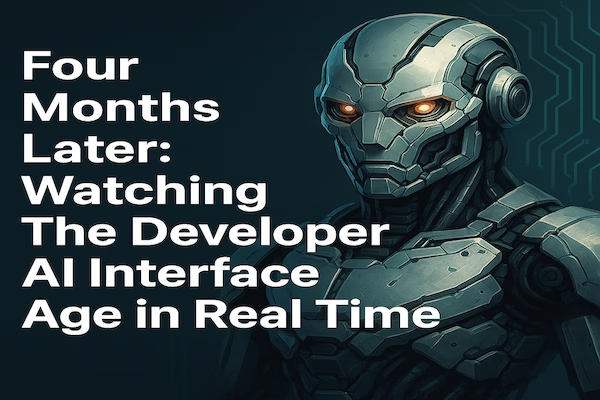Earlier in the Summer I published a Kindle e-book, A Developer’s Guide to AI: Reaching Maximum Output Efficiency. I called chapter 1 “The Developer AI Interface,” and at the time it felt like I had captured the moment: Copilot was the flagship, Cursor was the disruptor, and developers everywhere were learning how to collaborate with machines rather than simply code with them.
But here we are, just four months later, and that chapter already reads like a time capsule.
The speed at which this space is moving is staggering. Tools I described as “new” in May have already evolved beyond recognition. Entire platforms I didn’t even mention because they didn’t exist are now central to the conversation, to the way I work. Writing about the Developer AI interface in 2025 feels a bit like trying to sketch a coastline while the tide is coming in.
The New Landscape
Take Claude 4, for example. Back in May, it was gaining traction among AI enthusiasts and researchers. Today? It’s the engine behind GitHub Copilot, reshaping the most widely used developer assistant on the planet.
Or look at Windsurf Editor, which wasn’t even a blip on the radar when I drafted Chapter 1. It has since emerged as Cursor’s fiercest competitor, pulling developers into a debate over which AI-native IDE will define the future.
Meanwhile, OpenAI’s o-series, o3 and GPT-5, have landed with a focus on reasoning, planning, and tool use. These aren’t just bigger text predictors; they’re edging into territory that looks a lot like autonomous engineering partners.
Tools That Outran My Words
Even the tools I did write about look different now.
GitHub Copilot is no longer just “powered by OpenAI.” It has become a multi-model orchestration system, calling on different models for completions, reasoning, or refactoring. Cursor has rolled out Agent Mode, which doesn’t just autocomplete but actively traverses repos and manages code changes. Reasoning models now tie directly into build tools, package managers, and CI/CD workflows, something I described as “coming soon” that has already arrived.
And Then Came Claude Code and Claude Chat
Here’s the part that really drives home how fast things are moving: Claude Code and Claude Chat didn’t even exist in May.
Today, they feel indispensable.
- Claude Code has become a true developer environment, rivaling Cursor and Windsurf with deep repo awareness and autonomous debugging.
- Claude Chat is now the conversational layer many developers prefer, a place where long-context reasoning, architecture discussions, and integration hooks all converge.
The fact that I could write a chapter in May without mentioning them, and by September they’re headline players, tells you everything about the velocity of this field.
The Foundations Still Matter
And yet, here’s the irony: while the examples in Chapter 1 have aged, the frameworks in the book feel more relevant than ever.
The human-in-the-loop philosophy, the emphasis on security considerations, the KPI frameworks for measuring impact, and the change management strategies for adoption, none of that has gone out of date. In fact, as the tools become more powerful and more autonomous, those guardrails matter even more.
I didn’t write this book to chase features; I wrote it to help developers and teams navigate the chaos with structure. That part still holds.
A Moving Horizon
If writing Chapter 1 taught me anything, it’s this: the Developer AI interface is not a fixed frontier. It’s a moving horizon. What feels current today may look outdated in 120 days.
That’s not failure, that’s the nature of this space. It’s why I framed the book as a field guide rather than a one-time playbook, it’s why one quarter later chapters and the book need to be re-worked. The tools will keep shifting. The pace won’t slow down. But the way we think about integrating them, practically, securely, and with human oversight, will remain the constant.
So yes, Chapter 1 is already out of date. But the lessons underneath it? They’re more alive than ever.
The Critical Updates
1. New Major Players
- Claude 4 is now powering GitHub Copilot, turning what was already the dominant assistant into something far more capable.
- Windsurf Editor has entered the arena as a serious Cursor competitor, pushing innovation in AI-native IDEs.
- OpenAI’s o-series, with o3 and GPT-5, has reset expectations again, especially around reasoning and planning.
2. Tool Evolution
- Copilot is multi-model now, orchestrating completions, reasoning, and refactoring through the best-suited model.
- Cursor’s Agent Mode transforms it from an autocomplete assistant into a genuine repo-level collaborator.
- Reasoning models integrate directly with tools like package managers, CI/CD pipelines, and cloud services.
3. Capability Shifts
- Autonomous agentic coding is edging closer to mainstream workflows.
- Multi-file refactoring is increasingly seamless, no longer a brittle feature.
- Hybrid local/cloud architectures are normalizing, giving devs flexibility around performance and data security.
4. Updated Benchmarks
- Claude Sonnet 4 leads SWE-bench at 72.7%, establishing a new standard for software engineering benchmarks.
- New workflow-focused evaluation metrics better reflect developer productivity than token-level accuracy ever could.
What Still Stands Strong
While the tools and benchmarks evolve at lightning speed, the frameworks in the book remain highly relevant:
- Human-in-the-loop approach: Even as models become more autonomous, developer oversight remains essential.
- Security considerations: With hybrid architectures and agentic code, attack surfaces expand, making secure adoption strategies even more important.
- KPI measurement frameworks: Teams still need clear metrics for evaluating ROI and productivity gains.
- Change management strategies: Adoption at scale is more about people and processes than features.
The book’s core strength is its practical, balanced perspective: AI as a powerful assistant, not a replacement. That lens becomes more valuable, not less, as autonomy increases.

No responses yet